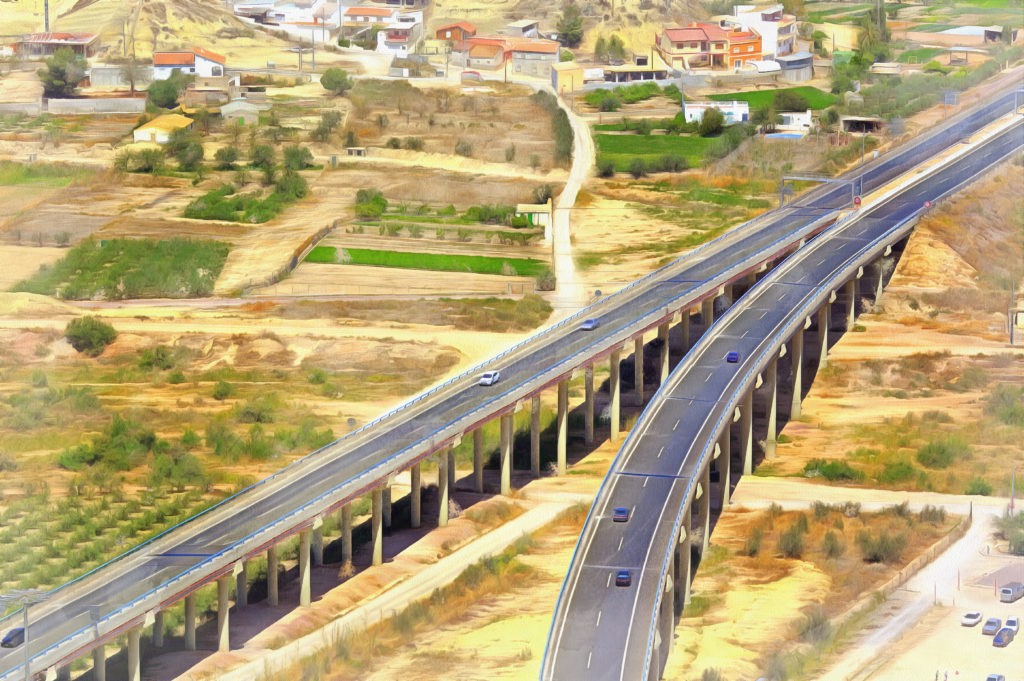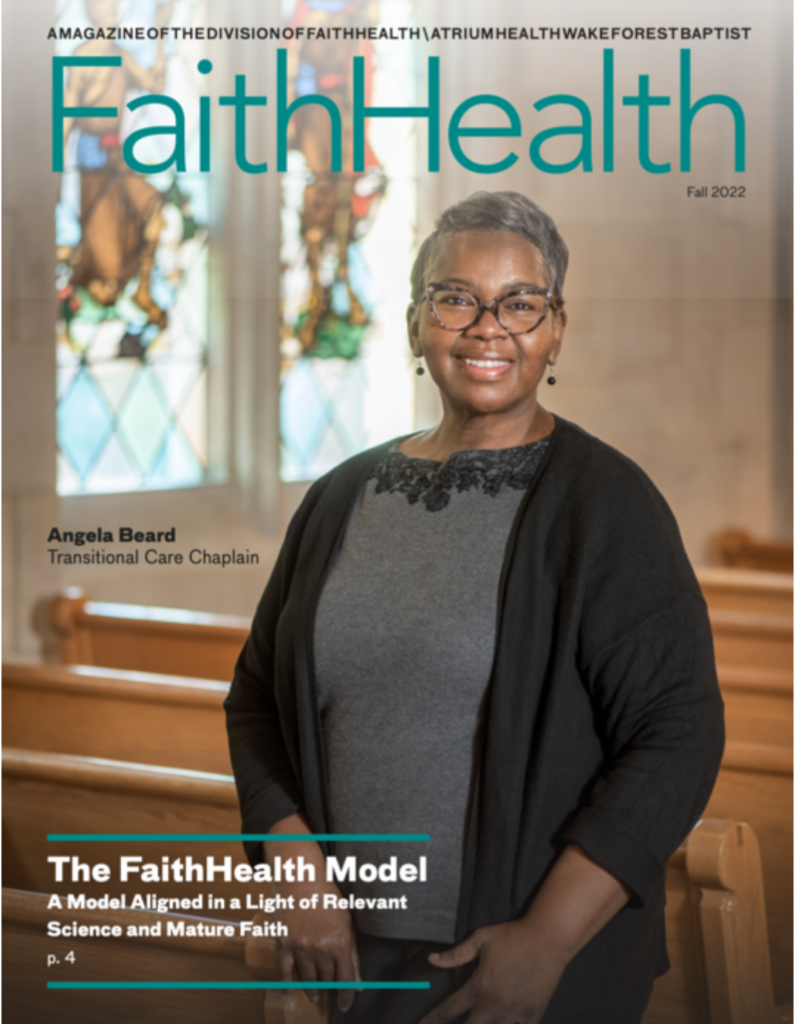By Gary Gunderson
These United States are always becoming something new, always moving. And if you want to see and understand this dynamic, it helps to get close enough to see it move. Over the past two years, some colleagues and I have driven the long highways — one road trip in a Winnebago, one in a Mini Cooper. Absent were the lectures, microphones, PowerPoints or ticking clocks you would experience at a big-deal national conference in a fancy hotel. It was just us listening for — and finding — the movement of FaithHealth.
The FaithHealth movement is alive in every community — from San Diego, California, to Wilmington, North Carolina; from El Paso, Texas, to Big Timber, Montana — where small groups organize themselves at the intersection of their most mature faith and some stream of relevant science. Mature means generous and generative — partnering with the Creator for the community that God so loves.
Relevant science is the body of thought and practice validated, tested, vetted by no-kidding scientists — the tools tuned to the challenge and opportunity at hand. If God calls you into the lives of vulnerable moms and their young kids, don’t go without the relevant science. If you find yourselves ministering in a pandemic, ditto. Fortunately, this movement, the joining of faith and health, is growing. In every community we visited we found robust relationships between the local public health department or college or hospital and the emerging networks of faith.
Of course, this has been happening a long time, as you can see in our iconic stories of faith. What moved the Good Samaritan as he helped the traveler who had been robbed and beaten? And it is what you see happening in hundreds, no,  thousands, of stories almost too common to notice happening in the movement. Some places FaithHealth shows up are where you would expect to see integration of faith and science — in medical centers established long ago by people of faith, such as Wake Forest Baptist Medical Center. Most of the stories are not in halls of medicine, but on the streets where modern Samaritans walk as neighbors and first responders, public health nurses coming alongside single moms and their kids, people showing inexplicable compassion for others they have no reason to notice under the bridge except that God makes us recognizable to each other.
thousands, of stories almost too common to notice happening in the movement. Some places FaithHealth shows up are where you would expect to see integration of faith and science — in medical centers established long ago by people of faith, such as Wake Forest Baptist Medical Center. Most of the stories are not in halls of medicine, but on the streets where modern Samaritans walk as neighbors and first responders, public health nurses coming alongside single moms and their kids, people showing inexplicable compassion for others they have no reason to notice under the bridge except that God makes us recognizable to each other.
The root curiosity of FaithHealth is about life, not death or what’s trying to kill us. The medical field is way too much about germs and death. You can’t afford to be anything but clear-eyed about death rates in a pandemic. But over the course of a life, one needs to understand the causes of life, too.
Healthy Individuals and Social Webs
The most significant finding in the health sciences in the past quarter century has not been in genetics or pharmaceuticals but the recognition of the nonmedical “determinants of health.” In 1998, the World Health Organization convened a panel of experts who announced that actually health is mostly shaped over a lifespan by nonmedical processes that they lumped in the category of “social.” In their categorization, pretty much everything useful the Samaritan did was social. But the word by itself doesn’t imply the radical power of the fuller phenomenon.
This oversimplification of the social hides the muscular tenacity of how we humans care for each other in complex and nuanced ways over time to not just heal after a wound, but to generate strengths that turn out to be relevant to the broad array of life. The communities that worship together are, of course, social, but they are much more. They work over time along all of the complex stages of life to form us as humans who know far more than biology about the potentials of life well lived that bears the fruit of the Spirit: love, joy, peace, patience, gentleness, goodness, faith, kindness and modesty. Those are health. And they determine health, not only of the individual but of the social webs in which those fruits are expressed.
 Movements are always inconvenient for those who like the way things are. Many in religious life like to live on the sidelines where they are free to pretend they know the secrets of the universe after handing off to nonprofit organizations most of the heavy lifting of family and social services. These spiritual specialists are called out into the open when something like a pandemic comes, exposing that we are all tightly interwoven and need to at least learn the names of those in the public health department. Likewise, on the health side where those running the business are happy to do so with preachers and prophets at a safe distance from the operational decision-making of who gets access to what services at what price, if at all. FaithHealth moves institutions and leaders into close relationship that may not be entirely comfortable or controllable by either.
Movements are always inconvenient for those who like the way things are. Many in religious life like to live on the sidelines where they are free to pretend they know the secrets of the universe after handing off to nonprofit organizations most of the heavy lifting of family and social services. These spiritual specialists are called out into the open when something like a pandemic comes, exposing that we are all tightly interwoven and need to at least learn the names of those in the public health department. Likewise, on the health side where those running the business are happy to do so with preachers and prophets at a safe distance from the operational decision-making of who gets access to what services at what price, if at all. FaithHealth moves institutions and leaders into close relationship that may not be entirely comfortable or controllable by either.
FaithHealth is an annoying challenge to all who dumb down faith into a spiritual sideshow. The Pew Research Center predicts that one in five churches will likely disappear in the next few years. Spirit is not enough by itself. FaithHealth may be an even more annoying challenge to those who dumb down the human experience to a set of interventions stripped of spirit. Jesus would have wept over a city that had a vaccine but did not know the things that make for shalom, the same fruits of the Spirit the Galatians knew long before germ theory.
FaithHealth is a set of ideas and practices that link healthy faith to relevant science. This picks a necessary quarrel; not all faith is healthy and not all science relevant. The point isn’t to suppress the unhealthy or irrelevant; just don’t feed it with your attention or energy. Let it go. Focus on the ideas and practices that lead toward life and away from the emptiness that signals death. The FaithHealth movement has produced a rich library of validated practices that help one distinguish life from death, if you need help. But in real life (the thing we live), our muscle memory is dependable as the Samaritan who did not need a single footnote to recognize the injured fellow human. Most FaithHealth practices at congregation or community system level are that obvious. The Samaritan spent little time on listing all the wounds; he began with what was possible and relevant — pick the guy up and get them to a hospitable place where he could heal. Pay a qualified inn-keeper. Promise to come back and to see what happens. Come back. If you notice people lying by the road every time you come this way, get some friends together to figure out what is creating the pattern, and try to fix it. Don’t overthink or underthink.
FaithHealth learned in the Memphis model that large networks of congregations can join with a hospital system to create a kind of compassionate social cloud that had demonstrated power far beyond a hospital alone to change patterns. The data showed that people from the congregations who had covenanted for health with each other tended to come to the right door (usually not just the emergency room), at the right time (depends on the problem or opportunity), ready to be helped (usually that meant not afraid), and not alone (meaning with somebody from their family or church who loves them).
This is both simple and not simple at all because there are so many possible doors and a fantastic array of conditions, each with its own ideal time for engaging a healer or helper. Ready to be helped and not alone are more profound since both are almost purely relational — am I known and welcome, not just insured; am I alone, or can those who love me come with me in this healing journey?
Health care operational technicians tend to focus on the right door and right time as obvious issues of “access,” which tend to be dumbed down into cost and payment. Much of why health care organizations have wanted to embrace FaithHealth is because it has demonstrated financial value in lowering the unpredictable cost of charity care and unnecessary utilization. It turns out that relationships of higher trust are cheaper for everyone. But here FaithHealth gets a bit annoying again in that trust can’t be claimed or declared on a brochure.
 FaithHealth is a web of practices that crosses over the boundaries between faith and health institutions, disciplines and structures. This is not just about the practices of the institutions on the faith side of the health journey that might deliver to the hospitals patients who are more compliant, more convenient and efficient to treat. Mature FaithHealth networks do accomplish that over time but only after the health care and public health institutions also comply with the most elemental moral characteristics of mercy and justice. Who exactly gets the vaccine when and at what cost? Where do the next millions of dollars of health care capital get invested? How far from the neighborhoods that need them most? How much of the hospital’s investable funds comply with the instructions of the New York bond rating agencies versus how much with anything that the prophet Micah might recognize as loving mercy and doing justice? Just as a virus crosses over and changes everything, so too does the integrated and subversive knowing at the heart of FaithHealth.
FaithHealth is a web of practices that crosses over the boundaries between faith and health institutions, disciplines and structures. This is not just about the practices of the institutions on the faith side of the health journey that might deliver to the hospitals patients who are more compliant, more convenient and efficient to treat. Mature FaithHealth networks do accomplish that over time but only after the health care and public health institutions also comply with the most elemental moral characteristics of mercy and justice. Who exactly gets the vaccine when and at what cost? Where do the next millions of dollars of health care capital get invested? How far from the neighborhoods that need them most? How much of the hospital’s investable funds comply with the instructions of the New York bond rating agencies versus how much with anything that the prophet Micah might recognize as loving mercy and doing justice? Just as a virus crosses over and changes everything, so too does the integrated and subversive knowing at the heart of FaithHealth.
FaithHealth moves us into places and relationships that give life a chance to express the generous heart of a loving God. If all we knew was biology or economics, the role of faith in health care would be simple — all about compliance with medical best practices and some prevention tips about flossing, jogging, and avoiding fat and sugar. It might tiptoe into some of the Medicaid models that are beginning to pay for some “social” things such as transportation and short-term housing. Faith radicalizes health, just as health radicalizes faith. Both sides of what is really one word make clear how much more mercy and justice it is possible to hope for. The early Christian movement drew people into a radical transparency of need and assets that made none go hungry and none go wealthy on their own. Only a mighty spirit can make that happen, but everywhere we are beginning to notice “unacceptable disparities” where we had only seen “normal,” and far more to work with where we had once complained of what we did not have.
A core tool of the FaithHealth movement is Community Health Assets Mapping. This process nearly always brings to visibility about six times as many organizations and networks relevant to health than anyone had thought about. The highly participatory process always flips the problem from having too little, to bringing order and priority to what to do first with all the community assets. The answer calls forth a whole new leadership talent, “boundary leadership,” that focuses on aligning the many kinds of assets previously hidden.
Patterns of Expression
Just as there are patterns in the mature expression of the fruits of the spirit in a person, we have begun to see predictable phases of mature expression of FaithHealth within a congregation. A first-step congregation may understand that its members have a stake in a healthy community. A fully mature one may feel its muscles rippling to engage beyond its members, even sending them for service in other places and organizations. It may have an active process for evaluating its efforts against a more sophisticated bio-psycho-social-spiritual understanding of FaithHealth. Its capacity to reflect and evaluate long-term missionary efforts makes it a respected leader among the ecology of organizations in the community. Others listen to its prophetic voice on stewardship, especially toward the poor and those left behind. It draws members in who want to be transformed and sent out. It becomes key to webs of trust that make possible bold dialogue and practical co-labor across boundaries.
We don’t need every congregation, much less every hospital and clinic, to allow themselves to be moved in the FaithHealth manner of movement. There are roughly 20,000 congregations between Winston-Salem and Macon, Georgia. This is the blended geography of Wake Forest Baptist Health and Atrium Health. If the doleful experts are right, the aftermath of COVID will bring that number down to 16,000 congregations in a couple years. That’s still a massive array of social and spiritual assets. What if even 10% of those — only 1,600 — were mature in five years? What if their muscles rippled and reached for the wounded, lost and left behind on all the pathways and streets of that region? What if they had such local and regional trust that every public health, social service and medical institution was drawn into a close working partnership that blended all we know that matters to health over a lifespan?
In the first issue of The Carter Center magazine that was one key wellspring of FaithHealth, Jimmy Carter said, “we must all make the choices that lead to life.” Today, the ideas of FaithHealth find expression in the thousands of practical acts of kindness, healing, mercy and justice-making underway in communities and neighborhoods across the nation.

